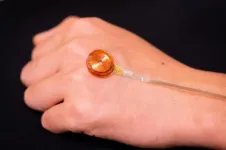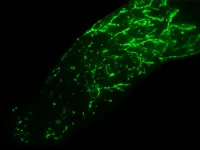INFORMATION:
This work was funded by Gusto Global, LLC. Daniel Van der Lelie, PhD, Chief Executive Officer of Gusto Global, is the first author of this study. Germ-free mice were provided by grants from the National Institutes of Health (NIH) and the Crohn's and Colitis Foundation.
'Good' bacteria show promise for clinical treatment of Crohn's disease, ulcerative colitis
A new study shows how a novel consortium of bacteria that live in the digestive tracts of healthy individuals can be used to prevent and treat aggressive colitis in humanized mouse models.
2021-05-28
(Press-News.org) CHAPEL HILL, NC - A new study published in Nature Communications demonstrates that a consortium of bacteria designed to complement missing or underrepresented functions in the imbalanced microbiome of inflammatory bowel disease (IBD) patients, prevented and treated chronic immune-mediated colitis in humanized mouse models. The study's senior author, Balfour Sartor, MD, Midget Distinguished Professor of Medicine, Microbiology and Immunology, Co-Director of the UNC Multidisciplinary IBD Center, said the results are encouraging for future use treating Crohn's disease and ulcerative colitis patients.
"The idea with this treatment is to restore the normal function of the protective bacteria in the gut, targeting the source of IBD, instead of treating its symptoms with traditional immunosuppressants that can cause side effects like infections or tumors," Sartor said.
The live bacteria consortia, called GUT-103 and GUT-108, were developed by biotech firm Gusto Global. GUT-103 is comprised of 17 strains of bacteria that work together to protect and feed each other. GUT-108 is a refined version of GUT-103, using 11 human isolates related to the 17 strains. These combinations permit the bacteria to stay in the colon for an extended amount of time, as opposed to other probiotics that are not capable of living in the gut and pass through the system quickly.
GUT-103 and GUT-108 were given orally three times a week to "germ-free" mice (no bacteria present) that had been specially developed and treated with specific human bacteria, creating a humanized mouse model. The therapeutic bacteria consortia worked by addressing upstream targets, rather than targeting a single cytokine to block downstream inflammation responses, and reversed established inflammation.
"It also decreased pathobionts - bacteria that can cause harm - while expanding resident protective bacteria, and produced metabolites promoting mucosal healing and immunoregulatory responses," Sartor said. "Simply put - the treatment increased the good guys and decreased the bad guys."
Because of the robust results seen in this study, and the need for more alternative therapies for Crohn's disease, Sartor would like to see GUT-103 and GUT-108 studied in Phase 1 and 2 clinical trials in the future. He plans to continue his work with Gusto Global to further explore uses of the bacterial consortia.
ELSE PRESS RELEASES FROM THIS DATE:
The dark matter particle explorer has measured high-precision cosmic ray helium energy spectrum
2021-05-28
Dark Matter Particle Explorer (DAMPE) Collaboration directly observed a spectral softening of helium nuclei at about 34TeV for the first time. This work was based on measurements data of the helium spectrum with kinetic energies from 70 GeV to 80 TeV (17.5 GeV/n to 20 TeV/n for per nucleon) recorded by the DAMPE.
The relevant results were published in Physical Review Letters.
Galactic cosmic rays (GCRs) offers important ways to deeply understand the astrophysical particle origin and accelerators and the interstellar medium of the Galaxy. Helium nuclei, the second most abundant nuclear element of cosmic rays, is a distinguishing feature of space.
As for GCRs, the energy spectrum is supposed to follow a negative power law distribution when energies are below the "knee" (at ...
Detecting skin disorders based on tissue stiffness with a soft sensing device
2021-05-28
By putting a piece of soft, strain-sensing sheet on the skin may be able to detect skin disorders non-invasively and in real-time very soon. A research team co-led by a scientist from City University of Hong Kong (CityU) has designed a simple electromechanical device that can be used for deep tissue pathology diagnosis, such as psoriasis, in an automated and non-invasive fashion. The findings will lay a foundation for future applications in the clinical evaluation of skin cancers and or dermatology diseases.
The research is co-led by Dr Yu Xinge, Assistant Professor from CityU's Department of Biomedical Engineering, and scientists from and Northwestern University in the US. Their findings have been published in the science journal Nature Biomedical Engineering, titled "Miniaturized ...
Revenge of the seabed burrowers
2021-05-28
New Haven, Conn. -- The ancient burrowers of the seafloor have been getting a bum rap for years.
These prehistoric dirt churners -- a wide assortment of worms, trilobites, and other animals that lived in Earth's oceans hundreds of millions of years ago -- are thought to have played a key role in creating the conditions needed for marine life to flourish. Their activities altered the chemical makeup of the sea itself and the amount of oxygen in the oceans, in a process called bioturbation.
But did that bioturbation help or hinder the expansion of complex animal life? A new Yale study, published in the journal Earth and Planetary Science Letters, found that ...
Ban on flavored vaping may have led teens to cigarettes, study finds
2021-05-28
New Haven, Conn. -- When San Francisco voters overwhelmingly approved a ballot measure banning the sale of flavored tobacco products in 2018, public health advocates celebrated. After all, tobacco use poses a significant threat to public health and health equity, and flavors are particularly attractive to youth.
But according to a new study from the Yale School of Public Health (YSPH), that law may have had the opposite effect. Analyses found that, after the ban's implementation, high school students' odds of smoking conventional cigarettes doubled in San Francisco's school district relative to trends in districts without the ban, even when adjusting for individual demographics and other ...
Electrons waiting for their turn: New model explains 3D quantum material
2021-05-28
This new 3D effect can be the foundation for topological quantum phenomena, which are believed to be particularly robust and therefore promising candidates for extremely powerful quantum technologies. These results have just been published in the scientific journal Nature Communications.
Dr. Tobias Meng and Dr. Johannes Gooth are early career researchers in the Würzburg-Dresdner Cluster of Excellence ct.qmat that researches topological quantum materials since 2019. They could hardly believe the findings of a recent publication in "Nature" claiming that electrons in the topological metal zirconium pentatelluride (ZrTe5) move only in two-dimensional ...
Open, expressive family life may reduce social deprivation effects among adopted children
2021-05-28
WHAT:
An environment in which family members support one another and express their feelings can reduce the effects of social deprivation on cognitive ability and development among adopted children, suggests a small study by researchers at the National Institutes of Health. In contrast, rule-driven households where family members are in conflict may increase an adopted child's chances for cognitive, behavioral and emotional difficulties.
The study was conducted by Margaret F. Keil, Ph.D., and colleagues in the Section on Endocrinology and Genetics at NIH's Eunice Kennedy Shriver National Institute of Child Health and Human Development (NICHD). It appears in Pediatric Research.
Researchers enrolled children who had spent at least eight ...
Natural gas pipeline density higher overall in more vulnerable US counties
2021-05-28
An analysis led by North Carolina State University researchers found counties with more socially vulnerable populations had a higher density of natural gas pipelines overall.
The findings suggest counties that are more socially vulnerable are also at greater risk of facing water and air pollution, public health and safety issues, and other negative impacts associated with the pipelines.
"We know that the network, as it stands today, is already distributed in such a way that any negative impacts fall disproportionately on vulnerable communities," ...
Better choice of contraceptives can prevent breast cancer
2021-05-28
Hormonal contraceptives, e.g. the pill, the patch, and the vaginal ring, contain synthetic hormones that prevent pregnancy by either stopping ovulation, changing the cervical mucus to stop sperm from passing through the cervix and finding an egg, or changing the womb's lining to prevent a fertilized egg from being implanted in it.
Despite their widespread use, hormonal contraceptives are known to increase the risk of breast cancer, which is the most common cause of cancer-related death among women worldwide, and also topped the list of most commonly diagnosed cancers in 2020.
The main component of hormonal contraceptives are progestins, ...
Moving one step closer to personalized anesthesia
2021-05-28
Anesthesia may be an exact science, but it's not yet fully personalized. Anesthesiologists use a variety of methods to calculate the right dose for a given patient: clinical studies, medical databases and laboratory measurements, for example. However, every individual responds to anesthetics in a different way, and there's no way of knowing what that response will be until the anesthetic is administered.
Personalizing dosage
Today patients often receive supplemental doses of an anesthetic during their operation based on their reaction. The role of anesthesiologists is to make sure that a patient doesn't wake up too soon and has no memory of the procedure, but they must use ...
Study identifies risk for some childhood cancer patients developing secondary leukaemia
2021-05-28
Scientists from the Wellcome Sanger Institute and the University of Cambridge found that in children with neuroblastoma - a cancer of immature nerve cells - treatment with platinum chemotherapy caused changes to the genome that could then cause leukaemia in some children later on.
The findings, published 27th May 2021 in Blood could lead to an ability to identify which children are more likely to develop the secondary cancer. This in turn could lead to changes in their treatment plan to either avoid these risks or take measures to prepare.
Secondary blood cancer is a challenging complication of childhood neuroblastoma cancer treatment. Every year around 100 children in the UK are diagnosed with neuroblastoma*, ...
LAST 30 PRESS RELEASES:
NTIDE: Disability employment holds steady after data hiatus
Social lives of viruses affect antiviral resistance
Dose of psilocybin, dash of rabies point to treatment for depression
Helping health care providers navigate social, political, and legal barriers to patient care
Barrow Neurological Institute, University of Calgary study urges “major change” to migraine treatment in Emergency Departments
Using smartphones to improve disaster search and rescue
Robust new photocatalyst paves the way for cleaner hydrogen peroxide production and greener chemical manufacturing
Ultrafast material captures toxic PFAS at record speed and capacity
Plant phenolic acids supercharge old antibiotics against multidrug resistant E. coli
UNC-Chapel Hill study shows AI can dramatically speed up digitizing natural history collections
OYE Therapeutics closes $5M convertible note round, advancing toward clinical development
Membrane ‘neighborhood’ helps transporter protein regulate cell signaling
Naval aviator turned NPS doctoral student earns national recognition for applied quantum research
Astronomers watch stars explode in real time through new images
Carbon-negative building material developed at Worcester Polytechnic Institute published in matter
Free radicals caught in the act with slow spectroscopy
New research highlights Syntax Bio’s platform for simple yet powerful programming of human stem cells
Researchers from the HSE University investigated reading in adolescents
Penn Nursing study: Virtual nursing programs in hospitals fall short of expectations
Although public overwhelmingly supports hepatitis B vaccine for a newborn, partisan differences exist
DFW backs UTA research to bolster flood resilience
AI brain scan model identifies stroke, brain tumors and aneurysms – helping radiologists triage and speed up diagnoses
U.S. News & World Report gives Hebrew Rehabilitation Center highest rating
Optica and DPG name Antoine Browaeys 2026 Herbert Walther Award recipient
The presence of a gun in the home increases the risk of suicide by three to five times
PFAS exposure and endocrine disruption among women
Vaccines and the 2024 US presidential election
New approach narrows uncertainty in future warming and remaining carbon budget for 2 °C
When pregnancy emergencies collide with state abortion bans
American College of Cardiology supports front of package nutrition labeling
[Press-News.org] 'Good' bacteria show promise for clinical treatment of Crohn's disease, ulcerative colitisA new study shows how a novel consortium of bacteria that live in the digestive tracts of healthy individuals can be used to prevent and treat aggressive colitis in humanized mouse models.




